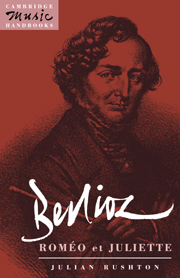Book contents
- Frontmatter
- Contents
- List of abbreviations and acknowledgements
- 1 Introduction
- 2 The genesis of Roméo et Juliette
- 3 Berlioz, Shakespeare, and Garrick
- 4 Exordium: Introduction and Prologue; Roméo seul
- 5 The heart of the matter: Scène d'amour; La reine Mab
- 6 Tragedy and reconciliation: Convoi funèbre; Roméo au tombeau; Finale
- 7 A view from 1839 by Stephen Heller
- 8 Performance and reception: 1839 and beyond
- 9 Afterword: Roméo et Juliette as covert opera
- Appendix 1
- Appendix 2
- Notes
- Select bibliography
- Index
1 - Introduction
Published online by Cambridge University Press: 18 November 2009
- Frontmatter
- Contents
- List of abbreviations and acknowledgements
- 1 Introduction
- 2 The genesis of Roméo et Juliette
- 3 Berlioz, Shakespeare, and Garrick
- 4 Exordium: Introduction and Prologue; Roméo seul
- 5 The heart of the matter: Scène d'amour; La reine Mab
- 6 Tragedy and reconciliation: Convoi funèbre; Roméo au tombeau; Finale
- 7 A view from 1839 by Stephen Heller
- 8 Performance and reception: 1839 and beyond
- 9 Afterword: Roméo et Juliette as covert opera
- Appendix 1
- Appendix 2
- Notes
- Select bibliography
- Index
Summary
In his preface to Roméo et Juliette, made available to its first audience in 1839 (see Appendix la), Berlioz insists that it is ‘a symphony, and not a concert opera’. The composer's view is of course to be respected, but need not end the argument. The seven movements of Roméo et Juliette resemble no previous symphony, not even the obvious, indeed only, precedent for a ‘symphonie avec choeurs’. Beethoven's Ninth, perhaps unknown to Berlioz when he first conceived Roméo, has the usual four movements, and voices appear only in the finale, as an additional sonorous resource and as bearers of a verbal message. In his Pastoral symphony, Beethoven required five movements, the last three playing continuously. Berlioz has five in the programmatic Symphonie fantastique, but while the ‘Marche au supplice’ and ‘Songe d'une nuit de Sabbat’ constitute, dramatically, a dream sequence as against the virtual reality of the first three movements, each movement is fully cadenced. This, rather than any work of Beethoven, is the nearest precedent for Roméo; but it does not, of course, involve voices.
Berlioz's intentions are clear enough on at least one level. He aimed to use the language of ‘expressive instrumental music’ in order to present the essence of the play in a work for the concert hall rather than the theatre. This choice, whether made out of aesthetic preference or because no other medium was available to him (see Chapter 2), enabled him to dispose instrumental and vocal forces freely in accordance with his preference for representing different aspects of the play in different ways: for instance, the lovers by instrumental music, the scene of reconciliation by music ‘in the domain of opera or oratorio’ (Preface, see Appendix 1a).
- Type
- Chapter
- Information
- Berlioz: Roméo et Juliette , pp. 1 - 6Publisher: Cambridge University PressPrint publication year: 1994



